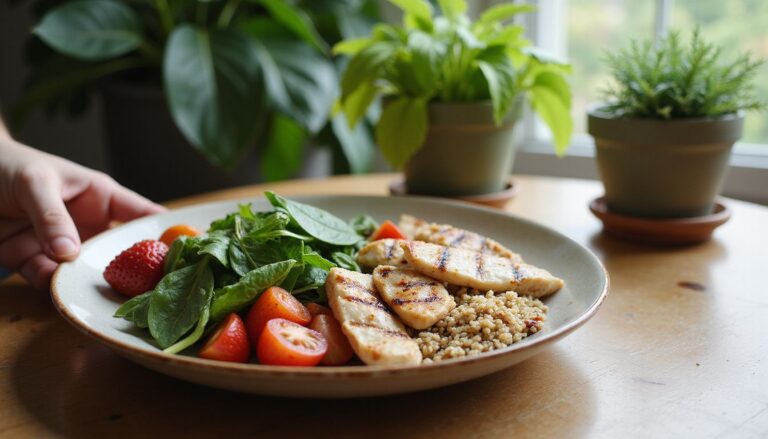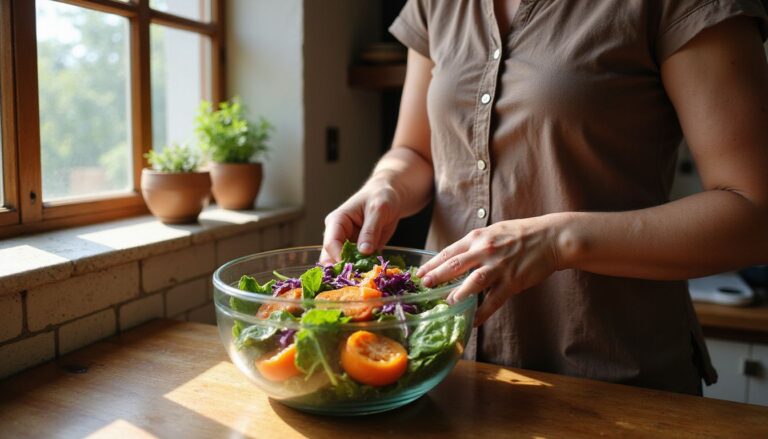Top 5 Low Calorie Snacks For A Healthy Diet
You want snacks that taste good and support a healthy diet. Low-calorie snacks make this easier, since many options land at 200 calories or less per serving. Choose smarter, and you can enjoy more food volume with fewer calories.
This guide shares five simple snack ideas that are filling and nutritious. Each one helps curb cravings and reduce overeating. Keep reading to find snack ideas for weight loss that help keep you full longer.
Key Takeaways
- Low-calorie snacks like fresh vegetables with hummus, Greek yogurt with berries, air-popped popcorn, apple slices with peanut butter, and edamame usually provide fewer than 200 calories per serving.
- Picking snacks with at least 5 grams of protein and a solid fiber source can control hunger for several hours and support steady blood sugar.
- Swapping processed snacks for nutrient-dense foods cuts added sugar, sodium, and unhealthy fats that can strain your heart over time.
- Use portion control, for example two tablespoons of peanut butter or one cup of edamame. You get key vitamins, minerals, protein, and fiber without overeating.
- Studies suggest choosing fruits and vegetables as snacks supports lower body weight. These foods have high water content and low energy density, meaning fewer calories per gram of food.

Why Low-Calorie Snacks Matter for Your Health

Low-calorie snacks help you stay energized between meals and support a healthy weight. Choosing nutrient-dense foods, which pack many vitamins and minerals into fewer calories, lets you eat well without blowing your daily calorie target.
What are the benefits of eating low-calorie snacks?
Healthy snack choices help you control calorie intake, which supports weight management. Options like raw carrots, air-popped popcorn, or Greek yogurt with berries often land under 200 calories per serving and still deliver important nutrients.
Fruits, vegetables, and edamame are high in fiber and water. That combination adds volume and helps you feel full longer with fewer calories.
Smart snacking keeps energy steady between meals without loading up on sugar or fat.
Fresh vegetables with hummus or apple slices with peanut butter supply protein, fiber, and antioxidants. These nutrients support heart health and may reduce disease risk over time. Choosing these foods makes it easier to skip ultra-processed snacks high in added sugar or saturated fat.
How do low-calorie snacks help with weight management?
Low-calorie snacks reduce total calories across your day, while still taking the edge off hunger. Pick foods with low energy density, meaning fewer calories per gram, such as carrots or popcorn. You get more bites for less energy intake.
Produce-rich snacks link with lower body weight over time. Protein and fiber from edamame or Greek yogurt slow digestion and extend fullness, which can lower the chances of overeating at your next meal.
You might notice that a small serving of low-fat cheese with whole-grain crackers or a portioned yogurt cup makes late-night nibbling less tempting. Simple, planned snack packs help you stay on track without feeling deprived.
Why choose nutrient-dense snack options?
Nutrient-dense snacks deliver vitamins, minerals, and fiber without many extra calories. For example, fresh vegetables with hummus or Greek yogurt with berries taste great and provide meaningful nutrition per bite.
A cup of cherry tomatoes has about 25 calories and supplies vitamin C, potassium, and antioxidants that support your immune system. Whole foods like edamame and almonds also bring protein and healthy fats, which help you feel satisfied longer than chips or cookies.
Pair protein with complex carbs for better satiety. Whole-grain crackers with low-fat cottage cheese is one easy example. People often feel full longer during calorie restriction when their snacks include more fiber and volume [1]. Simple add-ins like oats, seeds, or chickpeas can round out flavor and texture while boosting nutrition.
For a sweet snack, try banana slices with a light shake of cinnamon. It satisfies a sweet tooth without the sugar rush of many packaged treats.
[1] Rolls BJ et al., Satiety: The Role of Fiber,
Nutrition Reviews (1995)
How to Pick Healthy Low-Calorie Snacks
Reading ingredient lists and nutrition labels helps you make better choices. Stocking your kitchen with plain yogurt, dried fruit, and unsalted seeds makes healthier snacking easier.
How can I identify whole, unprocessed snack ingredients?
Scan the ingredient list for simple items like kale, apples, potatoes, or berries. Whole foods usually have one recognizable ingredient. Fresh or frozen fruits and vegetables such as broccoli, apple slices, blueberries, or edamame are minimally processed and easy to find in most markets.
Avoid snacks that include many additives, like colorings, artificial flavors, preservatives, or oil blends. Plain yogurt without added sugar and plain whole-wheat cereal are good fits.
Grabbing a handful of raw sunflower seeds instead of salted roasted ones is a quick upgrade. Short ingredient lists, ideally one or two items, are your best guide.
Next, see why protein and fiber make a powerful pair for sustained fullness.
Why should I choose snacks high in protein and fiber?
After you spot whole ingredients, pick snacks rich in protein and fiber. Protein supports muscles and tames hunger. Fiber is the part of plants that your body does not digest. It slows the rise in blood sugar and improves fullness.
Greek yogurt and edamame are reliable protein sources. Apples, berries, and carrots add fiber that helps you feel satisfied longer. Many people find that snacks with at least 5 grams of protein keep them full for two to three hours.
During a busy week, you might trade crackers for black bean dip and notice fewer energy dips. Simple options include fat-free milk, roasted soybeans, or a fruit smoothie blended with a spoon of sunflower seeds for texture.
Snacks that combine both nutrients support digestion and weight control. They raise nutritional value without adding many calories, which makes portion control easier.
What should I avoid in low-calorie snacks?
Watch for hidden sugar and sodium. Some low-calorie crackers or pretzels rely on added salt for flavor, which can raise blood pressure over time.
Heavily processed snacks may remove fiber and micronutrients, leaving you with empty calories. Scan for hydrogenated oils and other unhealthy fats in packaged baked goods or shelf-stable pastries.
If you prefer more natural options, avoid artificial sweeteners and unnecessary additives. Whole foods like fresh vegetables or lightly seasoned roasted edamame are usually better than highly processed choices from the refrigerator aisle.
Fresh Vegetables with Hummus
Fresh vegetables with hummus are crunchy, savory, and satisfying. This simple combo fits most eating styles and takes only minutes to prepare.
What nutrients do fresh vegetables provide?
Carrots, bell peppers, and cucumbers deliver vitamin C, vitamin A, potassium, and fiber. One cup of raw carrots provides more than the daily value for vitamin A. A cup of sliced red bell pepper can outpace an orange in vitamin C.
Leafy greens like spinach or kale add iron, calcium, and antioxidants. Antioxidants are protective plant compounds that help limit cell damage.
A single cup of mixed vegetables usually provides two to three grams of fiber, which supports regular digestion and helps with weight goals. The natural crunch makes snacking feel more satisfying than many processed snacks.
How does hummus complement fresh vegetables?
Vegetables bring fiber and vitamins. Hummus adds protein and healthy fats from chickpeas, sesame paste, and olive oil. This creamy dip coats cucumber rounds and pepper strips well and keeps every bite flavorful without heavy dressings.
The mix of crunch and creaminess boosts satisfaction. Protein slows digestion, so pairing hummus with vegetables tends to keep you full longer than veggies alone.
Measure 2 tablespoons of hummus for every cup of sliced vegetables. This portion keeps calories in check while delivering a satisfying snack.
Both ingredients fit plant-forward eating patterns. Hummus is a staple in Mediterranean cuisines, which are linked to heart benefits thanks to unsaturated fats from olives and other plants.
How can I prepare this snack quickly?
Wash and slice 1 cup of vegetables, such as carrots, cucumbers, or bell peppers. Place them on a plate with 2 tablespoons of hummus for dipping. No cooking is required.
Short on time? Use pre-cut vegetables from the grocery store. This quick setup delivers fiber, vitamins, and protein in under three minutes.
Next, see how Greek yogurt with berries can be an equally fast low-calorie snack.
Greek Yogurt with Mixed Berries
Greek yogurt with mixed berries is creamy, bright, and filling. It also gives you a high-protein base paired with colorful fruit rich in antioxidants.
Why is Greek yogurt high in protein?
Greek yogurt is strained to remove some liquid whey. This step concentrates protein and other nutrients. A typical 6-ounce serving has about 15 grams of protein, far more than many regular yogurts.
More protein supports muscle repair and helps you stay full longer. It also makes this snack easy to fit into a low-calorie plan.
What antioxidant benefits do berries offer?
Berries, including blueberries, strawberries, and raspberries, provide vitamin C and flavonoids, which are plant antioxidants. These compounds help fight free radicals, the unstable molecules that can harm cells over time.
Eating a cup of mixed berries can reduce markers of oxidative stress. Many people also notice steadier energy when they switch from candy to frozen berries for a sweet bite.
Diets that feature berries have been linked to heart benefits. With about 60 calories per cup, berries raise nutrients without adding much sugar.
What is the ideal portion size for this snack?
For balance, aim for three-fourths cup of plain Greek yogurt with one-half cup of mixed berries. This serving usually totals about 120 to 150 calories, depending on the fruit.
Stick with unsweetened yogurt to avoid hidden sugars. That way, the protein does the heavy lifting for fullness while the berries add vitamins and flavor.
Air-Popped Popcorn
Air-popped popcorn is light, crunchy, and filling. It offers the feel of a big snack with modest calories.
Why is air-popped popcorn a great low-calorie snack?
Air-popped popcorn runs about 30 calories per cup. It is a whole grain and has fiber that helps you feel satisfied. Three cups provide close to four grams of fiber, according to USDA data [2].
Popping with hot air instead of oil keeps calories and fat low. At home, an air popper or microwave popcorn maker can produce several cups with no added oil or sugar.
Season it yourself to control sodium and avoid sweet coatings found in many packaged versions.
How can I season popcorn without adding calories?
- Dust with nutritional yeast for a cheesy flavor and extra B vitamins with minimal calories.
- Shake on smoked paprika or chili powder for bold, savory notes without fat or sugar.
- Use garlic powder or onion powder for depth with virtually no calories.
- Toss with dried rosemary, thyme, or Italian seasoning for an aromatic finish.
- Squeeze a little lemon or lime juice for a bright taste with near-zero calories.
- Sprinkle cinnamon or pumpkin pie spice for a warm, sweet profile without added sugar.
- Finish with black pepper and a light pinch of salt. Keep salt modest if you monitor sodium.
These ideas keep popcorn flavorful and aligned with weight goals.
What is the best way to make air-popped popcorn?
Use an air popper. Add one-quarter cup of kernels, then start the machine. Hot air pops the kernels evenly with no oil.
Place a large bowl under the spout to catch the popcorn. You will get about eight cups at roughly 30 calories per cup. For better seasoning coverage, mist lightly with water, then add your spices so they stick.
Skip butter and heavy toppings to hold calories down and keep fiber benefits high [2].
Apple Slices with Peanut Butter
Apple slices with peanut butter deliver a crisp, creamy balance. This snack pairs natural fruit sugars with healthy fats for steady energy.
How do natural sugars and healthy fats work together in this snack?
Apples provide quick energy from natural sugars. Peanut butter adds healthy fats and protein, which slow the release of sugar into your bloodstream. That steadier pace helps avoid spikes and crashes.
Pairing carbs with fats and protein tends to curb hunger and support stable energy. This simple combo fits well in a low-calorie snack plan [3].
How do I choose the best peanut butter?
Check the label for short ingredient lists. Look for peanuts, or peanuts and salt. Skip spreads with hydrogenated oils, added sugar, or many stabilizers.
Choose a jar that offers at least 7 grams of protein per serving. If you track sodium, aim for 140 milligrams or less per 2 tablespoons. Natural options often separate, so give the jar a good stir before using.
Pick unsweetened varieties to keep calories and added sugar in check. Store in a cool place, or refrigerate after opening to maintain freshness.
What is the right portion size for this snack?
Use one medium apple and two tablespoons of natural peanut butter. That serving gives you about 180 calories with a balanced mix of carbs, healthy fats, protein, and fiber.
Measure the peanut butter so calories stay on target. Slice the apple for easy dipping and built-in portion control.
Edamame (Steamed Soybeans)
Edamame is quick, mild, and high in protein. It is an easy way to satisfy hunger with modest calories.
What makes edamame high in protein and fiber?
Edamame are young soybeans. They contain all nine essential amino acids, which makes them a complete protein. A one-cup serving of steamed edamame provides about 17 grams of protein and 8 grams of fiber, based on USDA data [2].
Eating the whole bean preserves more fiber than many processed soy products. This supports fullness and a healthy gut.
How do I prepare edamame simply?
- Buy fresh or frozen edamame in the pod.
- Bring a pot of water to a boil, then add a small pinch of salt if desired.
- Cook the pods for 3 to 5 minutes until they turn bright green.
- Drain and let them cool slightly.
- Season lightly with sea salt, black pepper, or chili flakes.
- Squeeze the beans from the pods as you eat. The pods are not edible.
- Serve warm or chilled. Both keep their nutritional value.
This method makes a fast, portable, high-protein snack.
When is the best time to enjoy edamame?
Have edamame as a midday snack to steady energy. The protein and fiber help bridge the gap between meals.
It also works well before or after a workout to support muscle recovery. Pack a cup for school, work, or travel to avoid impulse snacks.
Extra Tips for Healthy Snacking
Small planning steps make healthy snacking easier and more consistent. These tips help you get the most from low-calorie choices.
How does staying hydrated reduce unnecessary snacking?
Thirst can feel like hunger. Drinking water across the day prevents that mix-up and lowers the odds of grabbing extra snacks.
Keep a bottle nearby and sip often. Many people notice fewer cravings once they meet their fluid needs.
Why should I prepare snacks in advance?
Prep helps you avoid last-minute choices that are high in sugar, salt, or unhealthy fats. The CDC notes that planning supports healthier eating patterns [4].
Keep pre-cut vegetables, portioned cups of yogurt, or ready-to-pop popcorn on hand. Visible fruit increases healthy snack choices too.
You could pack single servings of edamame or apple slices at the start of the week. This habit keeps energy steady without relying on vending machines or drive-thrus.
How can I balance snacks with main meals?
Time your snacks at least two hours before or after meals. This spacing helps you arrive at mealtime hungry, not ravenous.
Stick to 100 to 200 calories per snack. Combine protein with produce, like Greek yogurt and berries or edamame with a clementine.
This pattern fills gaps in your diet and prevents overeating later.
Conclusion
Choosing low-calorie snacks supports your healthy diet and helps with weight management. The five options here offer protein, fiber, and key nutrients that help keep you full. They are quick to prep and fit well into busy days.
Set yourself up for success with simple planning and portion control. Keep whole foods on hand, such as vegetables, fruit, plain yogurt, and nuts. With a little prep, healthy snacking becomes a daily habit that boosts energy and mood.
This article provides general information and is not medical advice. If you have a health condition, food allergies, or diabetes, consult a healthcare professional before changing your diet.
References
- Rolls BJ, Bell EA. Satiety: The Role of Fiber. Nutrition Reviews. 1995.
- USDA FoodData Central. Nutrient data for popcorn, edamame, and related foods.
- Harvard T.H. Chan School of Public Health. Carbohydrates and Blood Sugar.
- Centers for Disease Control and Prevention. Healthy Eating for a Healthy Weight.
FAQs
1. What are the top five low calorie snacks for a healthy diet?
The top five low calorie snacks include Greek yogurt with berries, air-popped popcorn, carrot sticks with hummus, cottage cheese with cucumber slices, and apple wedges with almond butter. Each snack offers fewer than 150 calories per serving and provides essential nutrients such as protein or fiber.
2. How do these snacks support weight management?
These options help control hunger because they contain high amounts of protein or fiber. Studies show that eating foods rich in these nutrients can increase satiety and reduce overall calorie intake throughout the day (Harvard T.H. Chan School of Public Health).
3. Are there scientific studies supporting the benefits of these snacks?
Yes; research published in Nutrition Reviews highlights that dairy-based choices like Greek yogurt and cottage cheese improve fullness compared to higher-calorie alternatives. A study from The American Journal of Clinical Nutrition also found that whole fruits such as apples promote longer-lasting satiety than processed treats.
4. Can you share a personal experience using these snacks for better health?
After switching my afternoon snack from chips to carrot sticks with hummus, I noticed improved energy levels during work hours and less desire for sugary foods later in the day. This simple change made it easier to maintain steady focus while keeping daily calories within target range.
Summary: Choosing nutrient-dense low calorie snacks like Greek yogurt, air-popped popcorn, vegetables paired with dips, cottage cheese combinations, or fruit slices helps manage hunger without excess calories according to current nutrition science evidence.







